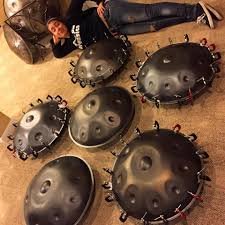Handpans - the magic steel
Maybe you’ve seen them being played by street performers, or at a party, or in a 'world music' ensemble. The handpan is a relatively new instrument which has gained a big following in recent years. In this article, we want to explain a bit about the background of the handpan and the way it's played and finish with a little overview of today's market for the ones interested in acquiring one of these wonderful instruments.

English-Swedish duo Hang Massive playing in the street.
What is a handpan?
A handpan is a circular instrument made of two steel hemispheres glued together, which is played, as the name suggests, with the hands.
Handpans are non-chromatic instruments, meaning that they do not have all 12 consecutive notes of a musical scale, as is the case, for example, with a piano. Instead, they come pre-tuned to varying scales and notes. However, in order to keep their typical harmonious sound, the notes on one handpan will all belong to one and the same scale, even though you will usually not find every note of this scale on the handpan. That is the reason why handpan play always sounds pleasant, no matter where you play on the instrument.

But handpans not only vary widely in the scale to which they are tuned and in the notes that you can play on each of them. Even the number of notes differs. Usually, seven or eight notes are tuned into the sound fields that create a handpan's tone circle. In addition, you have the Ding which is the center note (and lowest note), played on the dome in the center of the instrument, usually dented outward.
Hang Massive - The Secret Kissing of the Sun and Moon.
Though there are a wide variety of scales available, minor scales and specifically eastern-sounding scales are the most popular.
The first handpans were built by the Swiss company PANArt between 2000 and 2013. When PANArt registered the term Hang, meaning 'hand' in Bernese German, as trademark for their own instruments, the name handpan became popular.
How is a Handpan Played?

Zhenya Topov playing the handpan, Berlin.
One of the particularities of this instrument is that you can tap it anywhere, and it will create a sound, not just on the sound fields (tuned areas), but all around them, as well as on the backside and over the Gu – the circular opening in the bottom of the instrument.
There are many different ways of creating sound on a handpan. The usual way is by tapping it with the tip of a finger, but you can also use the knuckles, the fist, the inner part of the wrist or even a swiping movement of the hand. One can even play with a certain note by using the hollowed hand to manipulate the sound waves. A kind of vibrato can be created by playing a tone and then swiftly moving the hand over the respective tone field. Even a synthesizer-like electronic snare can be produced by playing a tone and then immediately 'closing it' by covering the sound with your hand.
Incorporating all of these moves and touches makes for a very diverse eclectic sound.
Today's Handpan Market
Nowadays there are about 150 handpan luthiers who manufacture instruments of different material, sound and quality.
In addition to offering different scales and notes, every 'tuner' has their own style. This means that the note might be exactly the same, but the sound can still be different. As a result you should first choose the scale that you would like and then give a good listen to, and if possible, play, the handpan yourself before you make your final decision.
The price depends on several factors, like the scale, material and amount of notes, but in general ranges from 1.000 to 3.000 Euros per handpan. But remember to have some patience – handpans are generally crafted by hand and a lot of attention goes into making them. You will usually encounter a waiting list which can be several months or even years long. Alternatively you could check for an available new or used one on Bbop.
Here are a few handpan manufacturers on today's market:
Innersound Handpan (Berlin, DE)
Innersound Sonoro, Workshop in Switzerland
Metalsounds (France)
Spacedrm New Generation Deep Sky Scale
Pandakini Handpans (Berlin, DE)
Pandakini Kurd 9
Pantheon Steel (USA)
New Era Halo 22 - Celtic Minor
Handpan Workshops
If you're in Berlin and would like to learn how to play a handpan, jam with others or are interested in buying an instrument, I recommend you check out the handpan workshops and classes offered by the Berlin Handpan Akademie of Zhenya Topov. The classes consist of exploring the different techniques of playing the handpan, the development of rhythms and sound patterns and group jams, and they are also just a lot of fun.
Hopefully you enjoyed this little article about these new and interesting instruments. Please let us know about your own experiences in the comments below!









 Other blog items you might be interested in...
Other blog items you might be interested in...


